On September 16, we marked a year since the death of 22-year-old Mahsa Amini following her arrest by the Iranian government’s “morality” police. The regime has harshly cracked down on protestors, especially women, since that time. In order to do so, it has installed a formidable system of digital surveillance.
Iran’s digital surveillance regime
Mahsa’s death set off protests against the mandatory hijab and the so-called “morality police” that made international headlines. The bravery of women, often leading the charge, cannot be overstated. The Iranian regime responded to the protests with severe punishments. Human rights organizations Equality Now, Femena and the Centre for Supporters of Human Rights, described these inhumane punishments and other human rights abuses in their joint submission to the UN Human Rights Committee, published in anticipation of the anniversary of Amini’s death.
In order to identify and punish dissidents, it has employed a sophisticated digital surveillance apparatus. The controversial new hijab bill is an example of both. The 70-article bill prescribes harsher penalties for women as well as severe sanctions against public figures, businesses and service providers who support them. The bill proposes the use of artificial intelligence to enforce dress code violations — a disturbing manifestation of gender-based persecution.
Digital technology has been a two-edged sword for Iranians: the same technology that has the potential to empower voices is being used to silence them. Using advanced facial recognition software and tracking online interactions, the government identifies and harasses those who dare to dissent. This technological might is disproportionately used against women, whose demands for equal rights are seen as direct threats to the state’s ideological foundation.
It’s not just about cameras on street corners or drones in the sky. The real Orwellian nightmare lies in the shadows of the internet. The government monitors popular platforms and can intercept traffic on encrypted messaging apps, which protesters often rely on for organizing. Bloggers, influencers and other ordinary citizens face intimidation, arrest or worse for simply expressing their opinions online.
Perhaps most disturbing is the state’s increasingly invasive eye into private spaces — the cars and walking routes of private citizens. In a chilling testament to this, a spokesman for Iran’s police boasted that over a million text message warnings had been sent to women over the span of just two months, as detailed by a harrowing report from Amnesty International. Warnings for what? Being unveiled in their own cars. In over 133,000 cases, police used text messages to order women not to use their vehicles, and they sent over 4,000 “repeat offenders” to court.
From Iran to the world: an international call to action
Digital rights are, at their core, human rights. A society where individuals cannot communicate freely, privately and securely is one where fundamental freedoms are under assault.
Digital rights are connected to the right to peaceful protests in multiple ways. Encrypted communication tools can offer activists and protesters a way to communicate without the fear of government interception or retribution. When mainstream media is censored or muzzled, social media platforms can allow for the rapid dissemination of information, rallying supporters for a cause. And the digital realm offers an expansive library of resources on peaceful protest tactics, rights awareness and international solidarity efforts.
Iran is far from the only regime restricting digital freedoms while using the same digital technology to suppress dissent or to surveil its citizens. In India, for example, police have made use of an app that allows citizens to turn their private CCTV systems over to police use, while in China mass surveillance has been used to gather information about the movements and activities of private individuals in a form of “predictive policing.” Across all these examples, there is evidence that surveillance and infringement on privacy rights disproportionately target individuals and groups whose identities make them vulnerable, such as women or minorities, or whose political activities challenge the status quo.
But here lies the challenge: As governments like these become more adept at quelling online dissent, how can activists stay a step ahead?
The international community can play a crucial role. We can pressure tech companies to safeguard user data and prioritize end-to-end encryption. We can counsel digital rights organizations and civil society on the threats posed by state-led digital surveillance and censorship and the implications of the technology being produced. Most importantly, as a global community, we can consistently spotlight abuses, ensuring governments understand that the world is watching. Regulation of the digital space along human rights principles will ensure that this does not become a new environment in which Iranian women, or any others, are vulnerable to abuse and harm.
While the Iranian government’s tactics are emblematic of a more significant global issue, the world must remember and uplift the unique bravery of Iran’s women, who stand tall even when shadows loom large. For Mahsa and countless others like her, we must persist in our shared fight for digital and human rights. Their courage deserves nothing less.
[Anton Schauble edited this piece.]
The views expressed in this article are the author’s own and do not necessarily reflect Fair Observer’s editorial policy.
The post Dissidents And Women Are Targeted By Iran’s High-Tech Surveillance appeared first on Fair Observer.
from World News - Independent, Nonprofit Media https://ift.tt/FM9WCS7 https://ift.tt/ZoR0PXs




0 Comments
Online Latest Bangla News, Article - Sports, Crime, Entertainment, Business, Politics, Education, Opinion, Lifestyle, Photo, Video, Travel, National, World.
Emoji